
The noted blogger Fjordman is filing this report via Gates of Vienna.

Kari Vogt, historian of religion at the University of Oslo, has stated that Ibn Warraq’s book “
Why I am Not a Muslim” is just as irrelevant to the study of Islam as The Protocols of the Learned Elders of Zion are to the study of Judaism. She is widely considered as one of the leading expert on Islam in the country, and is frequently quoted in national media on matters related to Islam and Muslim immigration. People who get most of their information from the mainstream media, which goes for the majority of the population, will thus be systematically fed biased information and half-truths about Islam from our universities, which have largely failed to uphold the ideal of free inquiry. Unfortunately, this situation is pretty similar at universities and colleges throughout the West.
London’s School of Oriental and African Studies (
SOAS), scene to a growing number of anti-Semitic incidents from an increasingly pro-Islamic campus, issued a threat to one of its Jewish students to cease his protests against anti-Semitism at the University. Gavin Gross, an American, had been leading a campaign against the deterioration of conditions for Jewish students at SOAS, which is part of the University of London. SOAS had witnessed an escalation of anti-Jewish activity, in both severity and frequency. At the beginning of the year, the Islamic Society screened a video which compared Judaism with Satanism.
Meanwhile, in a move to “promote understanding between Islam and the West,” Saudi Arabia donated about SR13 million to a
leading British museum. The officials said the money from Prince Sultan would pay for a new Saudi and Islamic gallery, which would help to portray Islamic culture and civilization in right perspectives. It would also help fund scholarships for Saudi students at Oxford University.

The Saudis and other oil-rich Arabs are busy buying influence over what Westerners hear about Islam. Prince Al-Waleed bin Talal bin Abdul Aziz Al-Saud, a member of the Saudi Royal Family, is an international investor currently ranked among the ten richest persons in the world. He is known in the USA for a $10 million check he offered to New York City Mayor Rudolph W. Giuliani in October 2001 for the Twin Towers Fund. Mayor Giuliani returned the gift when he learned that the prince had called for the United States to “re-examine its policies in the Middle East and adopt a more balanced stance toward the Palestinian cause.”
Prince Talal is also creating a TV channel,
Al-Resalah, to target American Muslims. He already broadcasts in Saudi Arabia. In 2005, Bin Talal bought 5.46% of voting shares in News Corp, the parent of Fox News. In December 2005 he boasted to Middle East Online about his ability to change what viewers
see on Fox News. Covering the riots in France that fall, Fox ran a banner saying: “Muslim riots.” Bin Talal was not happy. “I picked up the phone and called Murdoch... (and told him) these are not Muslim riots, these are riots out of poverty,” he said. “Within 30 minutes, the title was changed from Muslim riots to civil riots.”
A survey conducted by Cornell University found that around half of Americans had a
negative view of Islam. Addressing a press conference at the headquarters of the World Assembly of Muslim Youth (WAMY), Paul Findley, a former US Congressman, said that the cancer of anti-Muslim and anti-Islamic sentiments was spreading in American society and required corrective measures to stamp out. It was announced that the Council on American-Islamic Relations (CAIR) would be launching a massive $50 million media campaign involving television, radio and newspapers. “We are planning to meet Prince Alwaleed ibn Talal for his financial support to our project. He has been generous in the past.”
The World Assembly of Muslim Youth, founded by the nephew of Osama Bin Laden in the US, is sharing offices with the Islamic Society of North America and the Islamic Centre of Canada.
WAMY Canada runs a series of Islamic camps and pilgrimages for youth. US Special Agent Kane quoted from a publication prepared by the WAMY that said: “Hail! Hail! O Sacrificing Soldiers! To Us! To Us! So we may defend the flag on this Day of Jihad, are you miserly with your blood?! And has life become dearer to you? And staying behind sweeter?” According to him, 14- to 18-year-olds were the target audience for these teachings.
Harvard University and Georgetown University received
$20 million donations from Prince bin Talal to finance Islamic studies. “For a university with global aspirations, it is critical that Harvard have a strong program on Islam that is worldwide and interdisciplinary in scope,” said Steven E. Hyman, Harvard’s provost. Georgetown said it would use the gift – the second-largest it has ever received – to expand its Center for Muslim-Christian Understanding. Martin Kramer, the author of “Ivory Towers on Sand: The Failure of Middle Eastern Studies in America,” said: “Prince Alwaleed knows that if you want to have an impact, places like Harvard or Georgetown, which is inside the Beltway, will make a difference.”
Georgetown professor John Esposito, founding director of the Center for Muslim-Christian Understanding, has, probably more than any other academic,
contributed to downplaying the Jihadist threat to the West.
Kramer states that during his early days in the 1970s, Esposito had prepared his thesis under his Muslim mentor Ismail R. Faruqi, a Palestinian pan-Islamist and theorist of the “Islamization of knowledge.” During the first part of his career, John L. Esposito never studied or taught at a major Middle East center. In the 80s, he published books such as
Islam: The Straight Path, the first of a series of favorable books on Islam. In 1993, Esposito arrived at Georgetown University, and has later claimed the status of “authority” in the field.
In 2003, officials from the Islamic Society of North America (ISNA) recognized Esposito as the current
“Abu Taleb of Islam” and the Muslim community, not only in North America but also worldwide. In appreciation of his “countless effort towards dispelling myths about Muslim societies and cultures,” Dr. Sayyid Syeed, Secretary General of the ISNA compared the role of Esposito to that of Abu Taleb, Muhammad’s non-Muslim uncle who gave unconditional support to the Muslim community in Mecca at a time when it was still weak and vulnerable.
The rise to prominence of Esposito symbolizes the failure of critical studies of Islam – some would argue critical studies of just about anything non-Western – in Western Universities in the 1980s and 90s. Frenchman Olivier Roy as early as 1994 published a book entitled
The Failure of Political Islam and wrote of the Middle East as having entered the stage of “post-Islamism.” As Martin Kramer puts it, “the academics were so preoccupied with “Muslim Martin Luthers” that they never got around to producing a single serious analysis of bin Laden and his indictment of America. Bin Laden’s actions, statements, and videos were an embarrassment to academics who had assured Americans that “political Islam” was retreating from confrontation.

At least US Universities are noticing bin Laden now.
Bruce Lawrence, Duke professor of religion, has published a book of Osama bin Laden’s speeches and writings. “If you read him in his own words, he sounds like somebody who would be a very high-minded and welcome voice in global politics,” Lawrence said. Lawrence has also claimed that Jihad means “being a better student, a better colleague, a better business partner. Above all, to control one’s anger.”
Others believe we make too much fuss about this whole Jihad business.
John Mueller, Professor of Political Science at Ohio State University, in the September 2006 issue of Foreign Affairs asked whether the terrorist threat to the USA had just been made up: “A fully credible explanation for the fact that the United States has suffered no terrorist attacks since 9/11 is that the threat posed by homegrown or imported terrorists – like that presented by Japanese Americans during World War II or by American Communists after it – has been massively exaggerated.” “The massive and expensive homeland security apparatus erected since 9/11 may be persecuting some, spying on many, inconveniencing most, and taxing all to defend the United States against an enemy that scarcely exists.”
Lee Kaplan joined a conference of MESA, the Middle East Studies Association, in San Francisco: “Free copies of a glossy newsmagazine called the Washington Report on Middle East Affairs were being distributed to the academics in attendance. Most people, upon seeing the publication, might assume it was similar to Newsweek or Time.” “What most people don’t know is that the Washington Report on Middle East Affairs magazine and Web site – indeed, the entire organization behind it – are funded by Saudi Arabia, a despotic regime that has been quietly buying its way onto every campus in America, particularly through Middle East Studies centers in the U.S.”
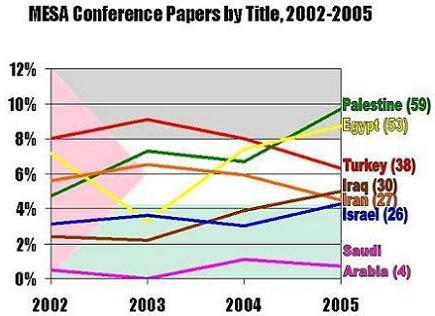
“I met Nabil Al-Tikriti, a professor from the University of Chicago.” “I’d invite those academic Middle East scholars who actually support America’s war effort overseas and security needs here at home. People like Daniel Pipes or Martin Kramer.” I continued, “Why aren’t they here at the MESA Conference?” “They’d be shouted down,” replied Al-Tikriti.
Jihad Watch Board Vice President Hugh Fitzgerald shares his
worries about MESA: “As an organization, MESA has over the past two decades slowly but surely been taken over by apologists for Islam.” “The apologetics consists in hardly ever discussing Jihad, dhimmitude, or indeed even introducing the students to Qur’an, Hadith, and Sira.” “Books on the level of [Karen] Armstrong and Esposito are assigned, and feelgood nonsense like Maria Rosa Menocal’s The Ornament of the World.”

“No member of MESA has done as much to make available to a wide public important new work on Muhammad, on the origins of the Qur’an, and on the history of early Islam, as that lone wolf, Ibn Warraq. No one has done such work on the institution of the dhimmi as that lone louve, Bat Ye’or. It is an astounding situation, where much of the most important work is not being done in universities, because many university centers have been seized by a kind of Islamintern International.”
Hugh Fitzgerald is right.
The Legacy of Jihad, one of the most important works on Jihad to appear in recent years, was written by Andrew Bostom, a medical doctor who was dissatisfied with much of the material available on the subject following the terror attacks in 2001. Bat Ye’or, perhaps the leading expert on the Islamic institution of dhimmitude, is self-taught. And Ibn Warraq has written several excellent books on the
origins of the Koran and the early days of Islamic history while remaining outside of the established University system. This is all a great credit to them personally, but it is not a credit to the status of Western Universities.
It is difficult to understand why American or Western authorities still allow the Saudis to fund what is being taught about Islam to future Western leaders, years after several Saudi nationals staged the worst terror attack in Western history. The United States didn’t allow Nazi Germany to buy influence at US Universities. Although the Soviet Communists had their apologists in the West as well as paid agents, the US never allowed the Soviet Union to openly sponsor its leading colleges. So why are they allowing Saudi Arabia and other Islamic nations to do so? The Saudis are enemies, and should be banned from exerting direct influence over our Universities and major media. It is a matter of national security.
Still, although bribes and Saudi oil money represent a serious obstacle to critical Western studies of Islam, they do by no means make up all of the problems. Quite a few academics are so immersed with anti-Western ideology that they will be happy to bash the West and applaud Islam for free.
Few works have done more to corrupt critical debate of Islam in Western institutions for higher learning during the past generation than the 1979 book
Orientalism by Edward Said. It spawned a veritable army of Saidists, or
Third World Intellectual Terrorism as Ibn Warraq puts it. According to Ibn Warraq, “the latter work taught an entire generation of Arabs the art of self-pity – “were it not for the wicked imperialists, racists and Zionists, we would be great once more” — encouraged the Islamic fundamentalist generation of the 1980s, and bludgeoned into silence any criticism of Islam.”
“The aggressive tone of
Orientalism is what I have called “intellectual terrorism,” since it does not seek to convince by arguments or historical analysis but by spraying charges of racism, imperialism, Eurocentrism” one anybody who might disagree. “One of his preferred moves is to depict the Orient as a perpetual victim of Western imperialism, dominance and aggression. The Orient is never seen as an actor, an agent with free-will, or designs or ideas of its own.”
Ibn Warraq also criticizes Said for his lack of recognition of the tradition of critical thinking in the West. Had he delved a little deeper into Greek civilization and history, and bothered to look at Herodotus’ great history, Said “would have encountered two features which were also deep characteristics of Western civilization and which Said is at pains to conceal and refuses to allow: the seeking after knowledge for its own sake.” “The Greek word,
historia, from which we get our “history,” means “research” or “inquiry,” and Herodotus believed his work was the outcome of research: what he had seen, heard, and read but supplemented and verified by inquiry.”
“Intellectual inquisitiveness is one of the hallmarks of Western civilisation. As J.M. Roberts put it, “The massive indifference of some civilisations and their lack of curiosity about other worlds is a vast subject. Why, until very recently, did Islamic scholars show no wish to translate Latin or western European texts into Arabic? Why when the English poet Dryden could confidently write a play focused on the succession in Delhi after the death of the Mogul emperor Aurungzebe, is it a safe guess that no Indian writer ever thought of a play about the equally dramatic politics of the English seventeenth-century court? It is clear that an explanation of European inquisitiveness and adventurousness must lie deeper than economics, important though they may have been.”

Martin Kramer points out the irony that novelist Salman Rushdie praised Said’s courage: “Professor Said periodically receives threats to his safety from the Jewish Defense League in America,” said Rushdie in 1986, “and I think it is important for us to appreciate that to be a Palestinian in New York — in many ways the Palestinian — is not the easiest of fates.” But as it happened, Said’s fate became infinitely preferable to Rushdie’s, after Khomeini called for Rushdie’s death in 1989. It was ironic that Rushdie, a postcolonial literary lion of impeccable left-wing credentials, should have been made by some Muslims into the very personification of Orientalist hostility to Islam.”
In his essay The Intellectuals and Socialism, F.A. Hayek noted already decades ago that “Socialism has never and nowhere been at first a working-class movement. It is a construction of theorists” and intellectuals, “the secondhand dealers in ideas.” “The typical intellectual need not possess special knowledge of anything in particular, nor need he even be particularly intelligent, to perform his role as intermediary in the spreading of ideas. The class does not consist of only journalists, teachers, ministers, lecturers, publicists, radio commentators, writers of fiction, cartoonists, and artists.” It also “includes many professional men and technicians, such as scientists and doctors.”
“These intellectuals are the organs which modern society has developed for spreading knowledge and ideas, and it is their convictions and opinions which operate as the sieve through which all new conceptions must pass before they can reach the masses.”
“The most brilliant and successful teachers are today more likely than not to be socialists.” According to Hayek, this is not because Socialists are more intelligent, but because “a much higher proportion of socialists among the best minds devote themselves to those intellectual pursuits which in modern society give them a decisive influence on public opinion.” “Socialist thought owes its appeal to the young largely to its visionary character.” “The intellectual, by his whole disposition, is uninterested in technical details or practical difficulties. What appeal to him are the broad visions.”
He warns that “It may be that as a free society as we have known it carries in itself the forces of its own destruction, that once freedom has been achieved it is taken for granted and ceases to be valued, and that the free growth of ideas which is the essence of a free society will bring about the destruction of the foundations on which it depends.” “Does this mean that freedom is valued only when it is lost, that the world must everywhere go through a dark phase of socialist totalitarianism before the forces of freedom can gather strength anew?” “If we are to avoid such a development, we must be able to offer a new liberal program which appeals to the imagination. We must make the building of a free society once more an intellectual adventure, a deed of courage.”
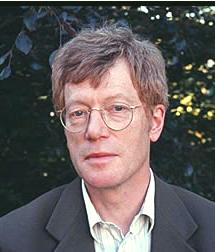
In his book
Modern Culture, Roger Scruton explains the continued attraction of left-wing ideology in this way:
“The Marxist theory is as form of economic determinism, distinguished by the belief that fundamental changes in economic relations are invariably revolutionary, involving a violent overthrow of the old order, and a collapse of the political “super-structure” which had been built on it. The theory is almost certainly false: nevertheless, there is something about the Marxian picture which elicits, in enlightened people, the will to believe. By explaining culture as a by-product of material forces, Marx endorses the Enlightenment view, that material forces are the only forces there are. The old culture, with its gods and traditions and authorities, is made to seem like a web of illusions – ‘the opiate of the people,’ which quietens their distress.”
Hence, according to Scruton, in the wake of the Enlightenment, “there came not only the reaction typified by Burke and Herder, and embellished by the romantics, but also a countervailing cynicism towards the very idea of culture. It became normal to view culture from the outside, not as a mode of thought which defines our moral inheritance, but as an elaborate disguise, through which artificial powers represent themselves as natural rights. Thanks to Marx, debunking theories of culture have become a part of culture. And these theories have the structure pioneered by Marx: they identify power as the reality, and culture as the mask; they also foretell some future ‘liberation’ from the lies that have been spun by our oppressors.”
It is striking to notice that this is exactly the theme of author Dan Brown’s massive international hit
The Da Vinci Code from 2003, thought to be one of the ten best-selling books of all time. In addition to being a straightforward thriller, the novel claims that the entire modern history of Christianity is a conspiracy of the Church to cover up the truth about Jesus and his marriage to Mary Magdalene.
Australian writer
Keith Windschuttle, a former Marxist, is tired of that anti-Western slant that permeates academia: “For the past three decades and more, many of the leading opinion makers in our universities, the media and the arts have regarded Western culture as, at best, something to be ashamed of, or at worst, something to be opposed. The scientific knowledge that the West has produced is simply one of many “ways of knowing.”
“Cultural relativism claims there are no absolute standards for assessing human culture. Hence all cultures should be regarded as equal, though different.” “The plea for acceptance and open-mindedness does not extend to Western culture itself, whose history is regarded as little more than a crime against the rest of humanity. The West cannot judge other cultures but must condemn its own.”
He urges us to remember how unique some elements of our culture are: “The concepts of free enquiry and free expression and the right to criticise entrenched beliefs are things we take so much for granted they are almost part of the air we breathe. We need to recognise them as distinctly Western phenomena. They were never produced by Confucian or Hindu culture.” “But without this concept, the world would not be as it is today. There would have been no Copernicus, Galileo, Newton or Darwin.”
The re-writing of Western history has become so bad that even playwright William Shakespeare has been proclaimed a closet Muslim. “Shakespeare would have delighted in Sufism,” said the Islamic scholar Martin Lings, himself a Sufi Muslim. According to The Guardian, Lings argued that Shakespeare’s “work resembles the teachings of the Islamic Sufi sect” in the International Shakespeare Globe Fellowship Lecture at Shakespeare’s own Globe Theatre in London. Lings spoke during Islam Awareness Week.
“It’s impossible for Shakespeare to have been a Muslim,” David N. Beauregard, a Shakespeare scholar and coeditor of Shakespeare and the Culture of Christianity in Early Modern England, told. Shakespeare “maintained Roman Catholic beliefs on crucial doctrinal differences.” Beauregard notes that “this is not to say that Shakespeare was occupied with writing religious drama, but only that a specific religious tradition informs his work.”
According to
Robert Spencer, “Shakespeare is just the latest paradigmatic figure of Western Christian culture to be remade in a Muslim-friendly manner.” Recently the [US] State Department asserted, without a shred of evidence, that Christopher Columbus (who in fact praised Ferdinand and Isabella for driving the Muslims out of Spain in 1492, the same year as his first visit to the Americas) was aided on his voyages by a Muslim navigator. “The state of American education is so dismal today that teachers themselves are ill-equipped to counter these historical fantasies.”
The
Gates of Vienna blog quoted a report by The American Council of Trustees and Alumni (ACTA) on US Universities. Their survey revealed “a remarkable uniformity of political stance and pedagogical approach. Throughout the humanities and social sciences, the same issues surface over and over, regardless of discipline. In courses on literature, philosophy, and history; sociology, anthropology, and religious studies; women’s studies, American studies, [..,] the focus is consistently on a set list of topics: race, class, gender, sexuality, and the “social construction of identity”; globalization, capitalism, and U.S. “hegemony”; the ubiquity of oppression and the destruction of the environment.”
“In class after class, the same essential message is repeated, in terms that, to an academic “outsider,” often seem virtually unintelligible.” “In short, the message is that the status quo, which is patriarchal, racist, hegemonic, and capitalist, must be “interrogated” and “critiqued” as a means of theorizing and facilitating a social transformation whose necessity and value are taken as a given.” “Differences between disciplines are beginning to disappear. Courses in such seemingly distinct fields as literature, sociology, and women’s studies, for example, have become mirror images of one another.”
Writer Charlotte Allen commented on how Harvard University President Lawrence Summers caused a storm by giving a speech speculating that innate differences between the sexes may have something to do with the fact that proportionately fewer women than men hold top positions in science. Summers in 2006 announced his intention to step down at the end of the school year, in part due to pressure caused by this speech. “Even if you’re not up on the scientific research – a paper Mr. Summers cited demonstrating that, while women overall are just as smart as men, significantly fewer women than men occupy the very highest intelligence brackets that produce scientific genius – common sense tells you that Mr. Summers has got to be right. Recently, Harvard’s Faculty of Arts and Sciences passed a vote of no confidence in Mr. Summers. Wouldn’t it be preferable to talk openly about men’s and women’s strengths and weaknesses?”
Yes, Ms. Allen, it would. Summers may have been wrong, but it’s dangerous once we embark on a road where important issues are not debated at all. One of the hallmarks of Western civilization has been our thirst for asking questions about everything. Political Correctness is thus anti-Western both in its form and in its intent. It should be noted that in this case, Feminists were in the vanguard of PC, the same ideology that has blinded our Universities to the Islamic threat.
It makes it even worse when we know that other Feminists in academia are asserting that the veil, or even the burka, represent “an alternative Feminism.” Dr. Wairimu Njambi is an Assistant Professor of “Women’s Studies” at the Florida Atlantic University. Much of her scholarship is dedicated to advancing the notion that the cruel practice of female genital mutilation (FGM) is actually a triumph for Feminism and that it is hateful to suggest otherwise. According to Njambi “anti-FGM discourse perpetuates a colonialist assumption by universalizing a particular western image of a ‘normal’ body and sexuality.”

Still, there are pockets of resistance.
Professor Sigurd Skirbekk at the University of Oslo questions many of the assumptions underlying Western immigration policies. One of them is the notion that rich countries have a duty to take in all people from other nations that are suffering, either from natural disasters, political repression or overpopulation. According to him, it cannot be considered moral of the cultural, political and religious elites of these countries to allow their populations to grow unrestrained and then push their excess population onto other countries.
Skirbekk points out that European countries have earlier rejected the Germans when they used the argument of
lebensraum as a motivation for their foreign policy. We should do the same thing now when other countries invoke the argument that they lack space for their population. According to him, there is plenty of literature available about the ecological challenges the world will be facing in this century. Running a too liberal immigration policy while refusing to confront such unpleasant moral issues is not a sustainable alternative in the long run. We will then only push difficult dilemmas onto future generations.
In Denmark,
linguist Tina Magaard concludes that Islamic texts encourage terror and fighting to a far greater degree than the original texts of other religions. She has a PhD in Textual Analysis and Intercultural Communication from the Sorbonne in Paris, and has spent three years on a research project comparing the original texts of ten religions. “The texts in Islam distinguish themselves from the texts of other religions by encouraging violence and aggression against people with other religious beliefs to a larger degree. There are also straightforward calls for terror. This has long been a taboo in the research into Islam, but it is a fact we need to deal with.”
Moreover, there are hundreds of calls in the Koran for fighting against people of other faiths. “If it is correct that many Muslims view the Koran as the literal words of God, which cannot be interpreted or rephrased, then we have a problem. It is indisputable that the texts encourage terror and violence. Consequently, it must be reasonable to ask Muslims themselves how they relate to the text, if they read it as it is,” says Magaard.
The examples of Skirbekk, Magaard and others are indeed encouraging, but not numerous enough to substantially change the overall picture of Western academics largely paralyzed by Political Correctness and anti-Western sentiments.

Writer Mark Steyn comments on how “out in the real world it seems the true globalization success story of the 1990s was the export of ideology from a relatively obscure part of the planet to the heart of every Western city.” “Writing about the collapse of nations such as Somalia, the Atlantic Monthly’s Robert D. Kaplan referred to the “citizens” of such “states” as “re-primitivized man.”
“When lifelong Torontonians are hot for decapitation, when Yorkshiremen born and bred and into fish ‘n’ chips and cricket and lousy English pop music self-detonate on the London Tube, it would seem that the phenomenon of “re-primitivized man” has been successfully exported around the planet. It’s reverse globalization: The pathologies of the remotest backwaters now have franchise outlets in every Western city.”
It is possible to see a connection here. While Multiculturalism is spreading ideological tribalism in our universities, it is spreading physical tribalism in our major cities. Since all cultures are equal, there is no need to preserve Western civilization, nor to uphold our laws.
It is true that we may never fully reach the ideal of objective truth, since we are all more or less limited in our understanding by our personal experiences and our prejudice. However, this does not mean that we should abandon the ideal. That’s what has happened during the past decades. Our colleges aren’t even trying to seek truth; they have decided that there is no such thing as “truth” in the first place, just different opinions and cultures, all equally valid. Except Western culture, which is inherently evil and should be broken down and “deconstructed.” Western Universities have moved from the Age of Reason to the Age of Deconstruction.
While Chinese, Indian, Korean and other Asian Universities are graduating millions of motivated engineers and scientists every year, Western Universities have been reduced to little hippie factories, teaching about the wickedness of the West and the blessings of barbarism. This represents a serious challenge to the long-term economic competitiveness of Western nations. That’s bad, but it is the least of our worries. Far worse than failing to compete with non-Muslim Asians is failing to identify the threat from Islamic nations who want to subdue us and wipe out our entire civilization. That is a failure we quite simply cannot live with. And we probably won’t, unless we manage to deal with it.
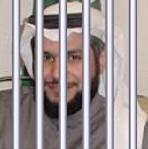 He’s got that right. The cultural differences between Colorado and Saudi Arabia are vast. But Mr. Al-Turki will have lots time to study this chasm of understanding as he grows old in prison. Well, he's a student, right? And they study, don't they? I mean, when he's not reading the Koran or praying. Or complaining.
He’s got that right. The cultural differences between Colorado and Saudi Arabia are vast. But Mr. Al-Turki will have lots time to study this chasm of understanding as he grows old in prison. Well, he's a student, right? And they study, don't they? I mean, when he's not reading the Koran or praying. Or complaining.
 Michelle Malkin calls this kind of thinking
Michelle Malkin calls this kind of thinking 
 Rick Moran placed first for a fine essay on a thorny and distressing subject --
Rick Moran placed first for a fine essay on a thorny and distressing subject -- 
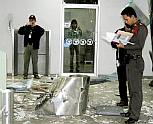 Nearly two dozen bombs exploded almost simultaneously Thursday inside commercial banks in southern Thailand, killing two people in a region bloodied by a Muslim insurgency, police said.
Nearly two dozen bombs exploded almost simultaneously Thursday inside commercial banks in southern Thailand, killing two people in a region bloodied by a Muslim insurgency, police said.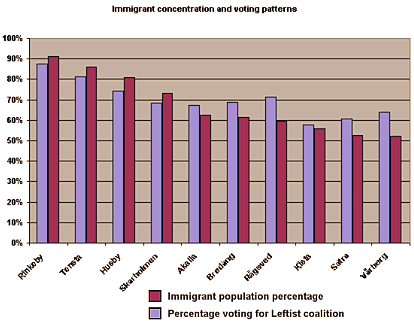

 The Saudis and other oil-rich Arabs are busy buying influence over what Westerners hear about Islam. Prince Al-Waleed bin Talal bin Abdul Aziz Al-Saud, a member of the Saudi Royal Family, is an international investor currently ranked among the ten richest persons in the world. He is known in the USA for a $10 million check he offered to New York City Mayor Rudolph W. Giuliani in October 2001 for the Twin Towers Fund. Mayor Giuliani returned the gift when he learned that the prince had called for the United States to “re-examine its policies in the Middle East and adopt a more balanced stance toward the Palestinian cause.”
The Saudis and other oil-rich Arabs are busy buying influence over what Westerners hear about Islam. Prince Al-Waleed bin Talal bin Abdul Aziz Al-Saud, a member of the Saudi Royal Family, is an international investor currently ranked among the ten richest persons in the world. He is known in the USA for a $10 million check he offered to New York City Mayor Rudolph W. Giuliani in October 2001 for the Twin Towers Fund. Mayor Giuliani returned the gift when he learned that the prince had called for the United States to “re-examine its policies in the Middle East and adopt a more balanced stance toward the Palestinian cause.” At least US Universities are noticing bin Laden now.
At least US Universities are noticing bin Laden now. 
 “No member of MESA has done as much to make available to a wide public important new work on Muhammad, on the origins of the Qur’an, and on the history of early Islam, as that lone wolf, Ibn Warraq. No one has done such work on the institution of the dhimmi as that lone louve, Bat Ye’or. It is an astounding situation, where much of the most important work is not being done in universities, because many university centers have been seized by a kind of Islamintern International.”
“No member of MESA has done as much to make available to a wide public important new work on Muhammad, on the origins of the Qur’an, and on the history of early Islam, as that lone wolf, Ibn Warraq. No one has done such work on the institution of the dhimmi as that lone louve, Bat Ye’or. It is an astounding situation, where much of the most important work is not being done in universities, because many university centers have been seized by a kind of Islamintern International.” Martin Kramer points out the irony that novelist Salman Rushdie praised Said’s courage: “Professor Said periodically receives threats to his safety from the Jewish Defense League in America,” said Rushdie in 1986, “and I think it is important for us to appreciate that to be a Palestinian in New York — in many ways the Palestinian — is not the easiest of fates.” But as it happened, Said’s fate became infinitely preferable to Rushdie’s, after Khomeini called for Rushdie’s death in 1989. It was ironic that Rushdie, a postcolonial literary lion of impeccable left-wing credentials, should have been made by some Muslims into the very personification of Orientalist hostility to Islam.”
Martin Kramer points out the irony that novelist Salman Rushdie praised Said’s courage: “Professor Said periodically receives threats to his safety from the Jewish Defense League in America,” said Rushdie in 1986, “and I think it is important for us to appreciate that to be a Palestinian in New York — in many ways the Palestinian — is not the easiest of fates.” But as it happened, Said’s fate became infinitely preferable to Rushdie’s, after Khomeini called for Rushdie’s death in 1989. It was ironic that Rushdie, a postcolonial literary lion of impeccable left-wing credentials, should have been made by some Muslims into the very personification of Orientalist hostility to Islam.” In his book
In his book  Still, there are pockets of resistance.
Still, there are pockets of resistance.  Writer Mark Steyn comments on how “out in the real world it seems the true globalization success story of the 1990s was the export of ideology from a relatively obscure part of the planet to the heart of every Western city.” “Writing about the collapse of nations such as Somalia, the Atlantic Monthly’s Robert D. Kaplan referred to the “citizens” of such “states” as “re-primitivized man.”
Writer Mark Steyn comments on how “out in the real world it seems the true globalization success story of the 1990s was the export of ideology from a relatively obscure part of the planet to the heart of every Western city.” “Writing about the collapse of nations such as Somalia, the Atlantic Monthly’s Robert D. Kaplan referred to the “citizens” of such “states” as “re-primitivized man.” We’ve been hearing a lot about the Shebaa Farms lately. This little piece of real estate is Hizbullah’s justification for opposing an Israeli “occupation” of Lebanese territory, and for continued violence against the state of Israel.
We’ve been hearing a lot about the Shebaa Farms lately. This little piece of real estate is Hizbullah’s justification for opposing an Israeli “occupation” of Lebanese territory, and for continued violence against the state of Israel.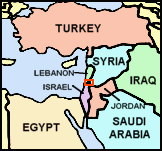 The Shebaa farms are in a little salient of Syrian territory, located near the point where Israel, Syria, and Lebanon come together. It’s part of the Golan Heights, a strategic section of mountainous Syrian territory captured by Israel in the Six-Day War and held ever since, awaiting a permanent peace treaty with Syria for disposition.
The Shebaa farms are in a little salient of Syrian territory, located near the point where Israel, Syria, and Lebanon come together. It’s part of the Golan Heights, a strategic section of mountainous Syrian territory captured by Israel in the Six-Day War and held ever since, awaiting a permanent peace treaty with Syria for disposition.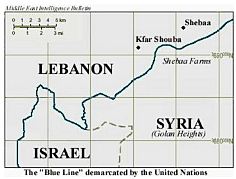 As with so many map features in the Middle East, it was created in 1923 when Ottoman territories acquired at the end of the Great War were divided between Britain and France. Syria and Lebanon were carved out and given a French Mandate, while Palestine, Trans-Jordan, and Iraq were handed over to the British. Boundaries were drawn rather arbitrarily and without much regard for local political and ethnic affiliations, so that the distinction between Syria and Lebanon was a convention imposed by the occupying powers.
As with so many map features in the Middle East, it was created in 1923 when Ottoman territories acquired at the end of the Great War were divided between Britain and France. Syria and Lebanon were carved out and given a French Mandate, while Palestine, Trans-Jordan, and Iraq were handed over to the British. Boundaries were drawn rather arbitrarily and without much regard for local political and ethnic affiliations, so that the distinction between Syria and Lebanon was a convention imposed by the occupying powers. Until the year 2000, that is. That’s when Israel withdrew fully from South Lebanon in accord with UN resolutions. The UN certified that the Israelis had fully complied with their obligations, and suddenly there was no more justification for referring to an Israeli “occupation” of Lebanon. But by that time the “occupation” was the entire rationale for Syria’s proxy, Hizbullah, and the basis for the group’s terrorist aggression.
Until the year 2000, that is. That’s when Israel withdrew fully from South Lebanon in accord with UN resolutions. The UN certified that the Israelis had fully complied with their obligations, and suddenly there was no more justification for referring to an Israeli “occupation” of Lebanon. But by that time the “occupation” was the entire rationale for Syria’s proxy, Hizbullah, and the basis for the group’s terrorist aggression. Such a deal would be a repeat of
Such a deal would be a repeat of